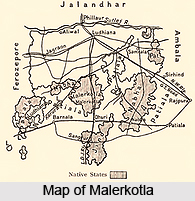 Princely State of Malerkotla or The State of Malerkotla or Maler Kotla was a princely state in the Punjab region during the era of British Empire in India. The last ruler of Maler Kotla signed the accession to join the Indian Union on 20th August 1948. Its rulers belonged to a Pathan, dynasty and its capital was in Malerkotla. The state belonged to the Punjab States Agency.
Princely State of Malerkotla or The State of Malerkotla or Maler Kotla was a princely state in the Punjab region during the era of British Empire in India. The last ruler of Maler Kotla signed the accession to join the Indian Union on 20th August 1948. Its rulers belonged to a Pathan, dynasty and its capital was in Malerkotla. The state belonged to the Punjab States Agency.
During the partition of India, the ruling family of Malerkotla State migrated to Pakistan and their members are living mostly in Model Town, Lahore, as well as in Muzaffargarh and Khangarh. The predecessor state was founded in 1454 A.D. by Sheikh Sadruddin-i-Jahan, a pious man of the Sherwani tribe of the Darban Kalan and Frontier Region of Drazinda from what is now the Dera Ismail Khan area, and was ruled by his descendents.
History of Princely State of Malerkotla
The local tradition says that Behlol Lodhi (1451-1517), the Afghan king who had most of western India under his control, desired to rule Delhi and on his way he was caught in a sand drift. In the darkness the King spotted a dim light of a lamp still burning in the wind. It was the hut of Sheikh Sadruddin and when the king found out he came to the hut to show his respect and asked the holy man to pray for him to bear a son and have victory. During 1451 and 1452, the king married off his daughter Taj Murassa to Shaikh Sadruddin after being enthroned in Delhi, and also gave him the area of Malerkotla as a jagir. The descendents of Shaikh Sadruddin branched into two groups. One started ruling the state and was given the title of Nawab. The other branch lived around the Shrine of Shaikh Sadruddin, controlling its revenue.
 Establishment of Princely State of Malerkotla
Establishment of Princely State of Malerkotla
State of Malerkotla was established in 1657 by Bayazid Khan. After saving the life of Mughal Emperor Aurangzeb in a tiger attack, Bayazid Khan was granted the privilege to build a fort, which he named Malerkotla and eventually gave its name to the state. On 3rd May 1809 Maler Kotla became a British protectorate and was made part of the Cis-Sutlej states until 1862. Malerkotla ranked 12th in the Punjab Darbar in 1890. It is noteworthy that during the 1947 riots when Punjab was in flames, the State of Malerkotla did not witness a single incident of violence; through it all, it remained a lone island of peace.
Communal Harmony in Princely State of Malerkotla
The roots of communal harmony in the area date back to 1705, when Sahibzada Fateh Singh and Sahibzada Zorawar Singh, 9 and 7 years old sons of 10th Sikh Guru, Guru Gobind Singh, were ordered to be bricked alive by the governor of Sirhind, Wazir Khan. His close relative, Sher Mohammed Khan, Nawab of Malerkotla, who was present in the court, lodged vehement protest against this inhuman act and said it was against Islam. Wazir Khan nevertheless had the Sahibzadas tortured and bricked into a section of wall while still alive. At this the Nawab of Malerkotla walked out of the court in protest. Guru Gobind Singh on learning this kind and humanitarian approach profusely thanked the Nawab of Malerkotla and blessed him with his Hukamnama, Kirpan etc. In recognition of this act, the State of Malerkotla did not witness a single incident of violence during partition. Many local people attribute this peaceful strain to the presence of the shrine of `Baba Haidar Sheikh`, the Sufi saint, who founded the town of Malerkotla more than 500 years ago.
Princely State of Malerkotla after India"s Independence
Following Indian independence and the signing of the instrument of accession to the Indian Union in 1948, Maler Kotla joined the newly established state of Patiala and East Punjab States Union (PEPSU) until its merger with Punjab in 1956.



















